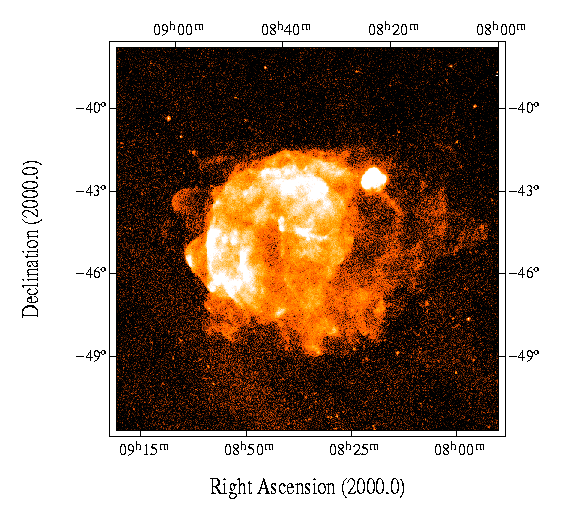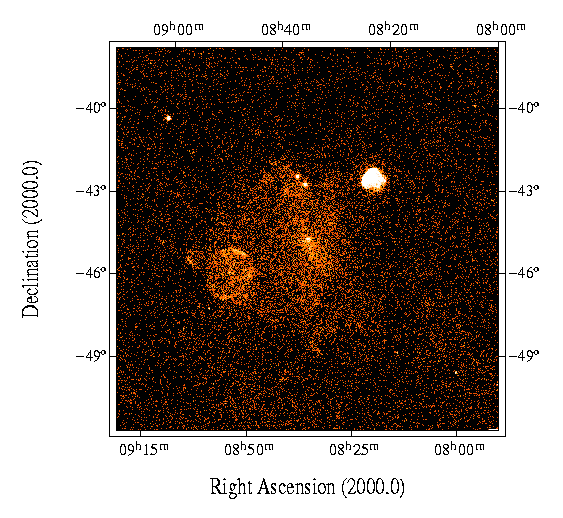A Young Nearby Supernova Remnant: Gamma-Ray and X-Ray Telescopes Confirm a Young, Nearby, Previously Unknown Supernova Remnant
A Summary by Christopher WanjekAstronomers have identified one of the closest, most recent supernova explosions yet. Using both the ROSAT X-ray telescope and the COMPTEL gamma-ray telescope on the Compton Gamma Ray Observatory, they observed a supernova remnant that is 650 light years away and that may have been seen on Earth in the early 14th century.*
A supernova occurs when a very large star uses up all its fuel and suddenly blows off most of its matter, radiating more energy than a billion suns. The supernova remnant (SNR), the expelled matter from the explosion, can be seen for thousands of years as the afterglow.
The discovery of this previously unknown SNR is interesting for two reasons:
- Astronomers using the COMPTEL telescope studied the remnant's titanium gamma-ray emission, a new technique proving to be a very good way to locating young SNRs.
- The SNR is so close and young, which is exciting in its own right. But this raises the question: why wasn't the supernova event itself recorded by earlier astronomers? When it exploded 680 years ago, it must have outshone everything in the night sky except the moon.
Concerning titanium, or 44Ti, to be exact: radioactive titanium is produced in the depths of a supernova explosion, and as it decays, it emits gamma rays. In general, gamma rays can penetrate through the dust and gas associated with supernova explosions, so we can detect these high-energy wavelengths more easily than optical light.
Because 44Ti has a lifetime of about 90 years, it can best be used to detect very young SNRs. Refer to the ROSAT images of the supernova region (Figures 1 and 2). What you are seeing is actually three supernova remnants. The smaller, bright ball in the upper right is the Puppis A SNR; the large fiery ball in the center is the Vela SNR; and the bright section hiding in the lower left corner of Vela is the newly identified SNR.
Now refer to the COMPTEL image produced by observing 44Ti gamma rays (Figure 3). The Puppis A and Vela SNRs "disappear" when we wear our gamma-ray glasses, and all we see is the newly detected supernova remnant. This is because Puppis A and Vela are much older SNRs, and their 44Ti has long since decayed. We see only the 44Ti remaining from the newer SNR.
Astronomers first realized the significance of the 44Ti emission line when observing the "Cassiopeia A" SNR. (Cassiopeia A itself exploded about 300 years ago.) Astronomers used CGRO to confirm that 44Ti was synthesized in and ejected by that supernova. They then searched the sky for other 44Ti sources and found this new SNR, currently named GRO J0852-4642. So, searching for gamma rays produced by 44Ti seems to be yet one more tool for discovering SNRs that may have been missed for whatever reasons by other observation techniques.
Concerning the lack of historical record: the supernova explosion was relatively nearby in our Galaxy and should have been easily seen by medieval astronomers, even during daylight hours. Yet there is no written record of the event.
The COMPTEL astronomers have a couple of guesses on why this may be. One reason may be simply that the explosion was in the southern sky, so folks far up in the northern hemisphere (i.e., Europe, much of the Islamic world and most of China) couldn't see it -- in the same way that they can't see the Southern Cross. Other reasons may be that the supernova was optically obscured by dust and other material in front of it, or that the supernova itself was "optically subluminous," a technical term for being much fainter than the average supernova.
One astronomer has an interesting theory on why China, which could have observed the supernova from its southern areas, did not make any recording of it. China experienced a period of turmoil with invasions from Mongolia, and changing governments reduced their funding for astronomical research. The supernova may have occurred during this period and was simply missed because of a lack of funding or manpower.
In 1604, astronomers around the world actually did observe an explosion directly of a different supernova, and we can still see the remnant today. Since then, though, we haven't been too lucky in observing a supernova explosion in our Galaxy first-hand. We can see nearly 200 SNRs in our Galaxy today, six of which are from explosions as recent as a 1,000 years. The numbers of historically observed supernova are fewer, thus our picture of supernovae remains incomplete.
We may never know why this southern supernova wasn't recorded. But we do have two favorable results from the discovery of its SNR: 44Ti works well in identifying young SNRs; and X-ray (from ROSAT) and gamma-ray observations (from CGRO) can work hand-in-hand in forming a picture of supernovae.
* The confusing issue here is that, by coincidence, the distance of the object in light-years and the time that it exploded in years are similar numbers: 650 light-years away, 680 years old. Technically, this source exploded about 1330 years ago. We didn't "see" it explode until about 680 years ago because it took 650 years for the light to reach us.
For "explosion" times, we use the date when the light from the explosion reaches earth. We say that Supernova 1987a exploded in 1987. This source is in the Large Magellanic Cloud, so it is about 180,000 light-years away. Thus, technically, this star exploded long before civilization on earth. Thirteen years ago, we finally got the news.
Go to the COMPTEL Page.
If you have a question about CGRO, please contact us via the Feedback form.




